Umbraco Review: Architecture, Features, and Pricing
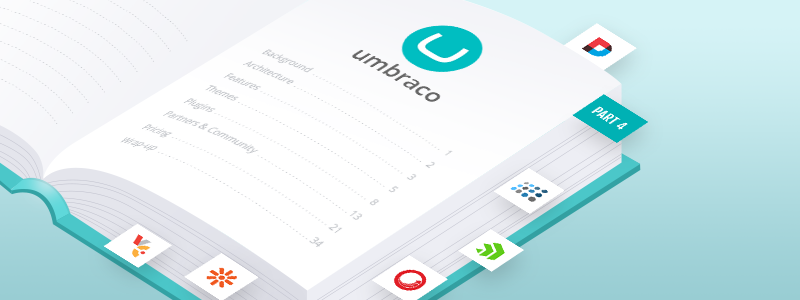
This article is part of a blog series dedicated to the best .NET e-commerce platforms out there - nopCommerce, Virto Commerce, DNN, Umbraco, Kentico, Sitecore, and Sitefinity.
So far, we have discussed nopCommerce, Virto Commerce, and DNN. We discussed each platform's architecture, features, capabilities, marketplace, ecosystem, and pricing.
In this blog post, we will talk about Umbraco.
Umbraco is not a .NET e-commеrce platform but rather an open-source CMS (content management system) based on ASP.NET.
Unlike other CMS platforms like Kentico, Sitecore, and Sitefinity, Umbraco doesn’t offer e-commerce features out-of-the-box.
Thus, if you want to run an e-commerce website on Umbraco, you will need to find a third-party e-commerce solution that integrates with Umbraco. Such solutions are Ucommerce and Merchello, for example.
But before we dive into the different features, let’s take a closer look into the history of Umbraco.
Umbraco History
The first prototype of Umbraco was built in 1999 by founder and CEO Niels Hartvig.
4 years later, in 2003, the first version of Umbraco was released.
In February 2005 the open-source version of the platform, Umbraco 2.0, was released. The same year the first annual Umbraco conference (Codegarden) took place in Copenhagen, Denmark.
In 2007 the Umbraco PRO version was released and in 2008 Umbraco launched its training program.
In 2009 Umbraco Courier 1.0 (a tool that enables you to move digital assets between Umbraco environments) and Umbraco Contour (a tool that enables you to build and design forms in Umbraco) were released. The same year Umbraco was recognized as one of the leading open-source CMS systems based on ASP.NET (by CMS Wire) and was listed as one of the top 10 CMS systems (by Version 2, a Danish magazine).
One year later, in 2010 Umbraco was refactored and its performance was significantly improved.
In January 2012 a rewrite of the framework (Version 5) was published. It was built using ASP.NET MVC. However, 5 months later, Version 5 was dropped due to performance problems. The next version of Umbraco, Version 6, was released in the beginning of 2013. It provided additional support for MVC4.
In November 2013, Umbraco released Version 7. The last stable version of Umbraco, Umbraco 7.10.2, was released in April 2018.
Note: If you want to know more about Umbraco’s background, you can check their ‘About us’ page.
Umbraco Architecture
- Built upon Microsoft’s .NET Framework, using ASP.NET MVC 4.5
- Supports Razor and XSLT view engines
- Umbraco API
Umbraco Features
Ucommerce Accelerator Storefront for Umbraco (Ucommerce for Umbraco)
Ucommerce for Umbraco can run on Umbraco CMS (an open-source free version of Umbraco) and Umbraco Cloud (a cloud version of Umbraco that enables you to host your website in Microsoft Azure).
Ucommerce was built specifically for Umbraco. Thus, it is the most sophisticated e-commerce solution for Umbraco.
Some of the more significant e-commerce features Ucommerce for Umbraco offers include:
- Multi-store support
- Multilingual support
- Multi-currency support
- Single management platform
- Multiple catalogs support
- Built-in template system for product presentations. You can easily present your products in different and engaging ways by using the templates.
- Fully customizable checkout. You can define your own checkout steps.
- CMS features. You can create custom landing pages, product pages, blog posts, and more. You can also easily manage and organize your content and digital assets.
- A framework-first structure and an open API enable you to integrate your e-commerce website with third-party ERP’s, CRM’s, PIM’s, marketing tools, etc.
- Ucommerce has its own Integration Engine called Uconnector. Uconnector enables you to exchange data between Ucommerce and third-party systems (such as Umbraco) much faster and extremely easy.
Merchello for Umbraco
Merchello is an open-source e-commerce package for Umbraco.
Some of the more significant features Merchello offers out-of-the-box include:
- Order and sales management. You can manage multiple shipments per order, capture payments, work with different suppliers, etc.
- Customer management. You can view each customer’s data (phone number, billing & shipping address, etc.), purchase history (number of orders, abandoned products, etc.), wishlist, and more. You can also update and organise all customer information.
- Multilingual support
- Multi-currency support
- SEO. Fully customizable URLs ensure that Google will love your website.
- Built-in marketing features. You can easily create rule-based discounts and coupons, create promotional campaigns, configure constraints associated with each campaign, and more.
- Analytics. You can automatically generate and view sales reports, cart abandonment reports, and more. Custom reports can also be created.
If you’re just starting out, you can use FastTrack - the Merchello Starter Kit that enables you to configure your e-commerce website in a few clicks.
Umbraco Themes
Umbraco doesn’t offer themes. Instead, you will have to work with a third-party expert that develops themes for Umbraco. Some of the more popular options include uSkinned and BindTuning.
Uskinned, for example, offers 9 responsive Umbraco themes and 1 starter kit. If you want to get a better idea of the themes and the features they sport, click here.
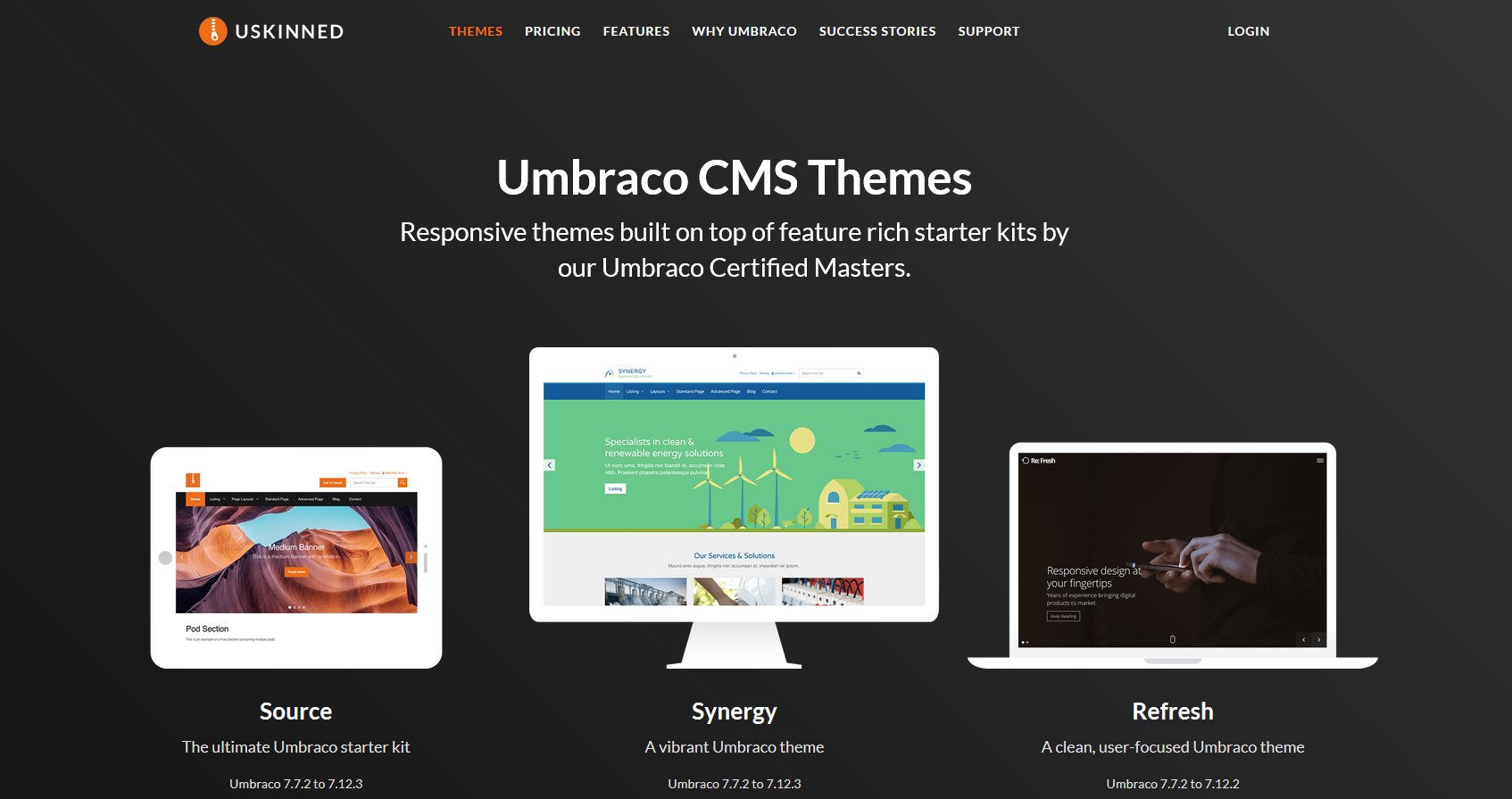
BindTuning offers 21 commercial themes. Click here to see their cost (all themes cost $49), number of downloads, a preview, and more.
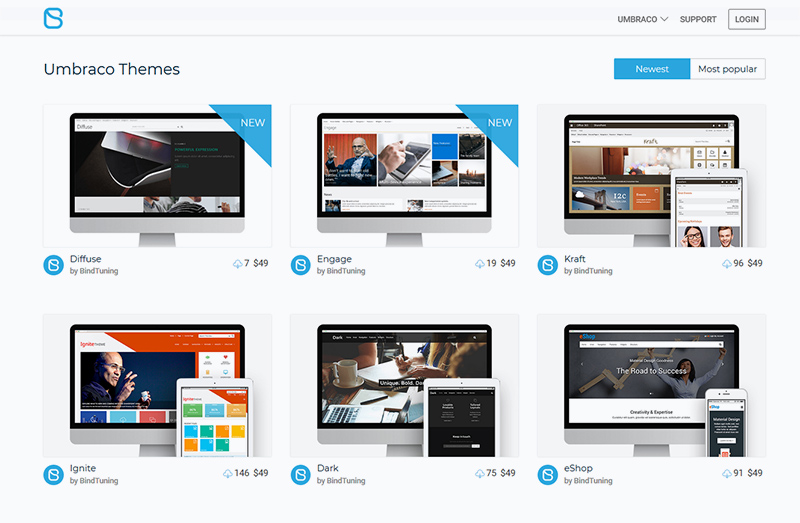
Ultimately, there isn’t a wide variety of e-commerce themes for Umbraco. However, since the platform is open-source, you can build a custom theme for your store. Everything (design, features, and capabilities) can be tailored to your specific needs. If you cannot develop a theme in-house, you can outsource it to a certified Umbraco expert or a .NET developer. In any case, additional costs are inevitable.
Umbraco Plugins
Umbraco offers a wide variety of plugins - there are more than 1,200 extensions (or packages) on Our Umbraco (the Umbraco marketplace and community website).
They are divided into 7 categories:
- Collaboration - this category consists of 67 extensions that enable you to add e-commerce features to your Ucommerce website (e.g. Merchello), integrate your store with third-party CRM systems (e.g. uslightly), add a ‘Contact us’ module to your website, and more.
- Backoffice extensions - this category consists of 553 extensions such as data types, URL shorteners, widgets, workflows, language packs, structure extensions, and more.
- Developer tools - this category consists of 251 extensions such as app managers, compression tools, surface controllers, and more.
- Starter Kits - this category consists of 44 starter kits that can help you set up and configure your online store.
- Umbraco Pro - this category consists of only 2 extensions: Umbraco Courier and Umbraco Contour.
- Website utilities - this category consists of 267 extensions such as a JavaScript carousel module, a Google Analytics integration, a Twitter integration, an XSLTsearch, a banner management system, an Ucommerce integration, and more.
- Umbraco Cloud - this category consists of 28 extensions such as Umbraco Forms, smart search solution, URL picker, analytics tool, and more, which are specifically developed to work with the cloud version of Umbraco.
Umbraco Partners & Community
Umbraco partners with more than 150 companies. The partner companies are classified as:
- Gold partners - companies that are closely connected to Umbraco. Currently, Umbraco has 87 gold partners. Click here to see a list of all gold partners.
- Certified partners - companies that are officially validated as partners. Currently, Umbraco has 71 certified partners. Click here to see a list of all certified partners.
- Registered partners - small agencies or individuals (developers, designers, etc.) who develop solutions on top of Umbraco.
You can filter the partners based on their skills (API development, architecture, content creation, e-commerce, etc.), sector (finance, healthcare, retail, etc.), and location.
You can mark the checkboxes for as many sectors, skills, and locations, as you want.
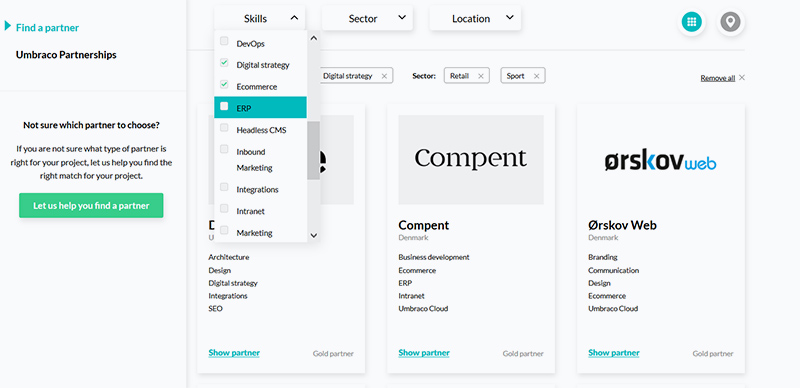
This enables you to easily find a suitable partner to work with.
For example, if you need help with anything e-commerce related, you can mark the ‘E-commerce’ checkbox. Then, you will see a list of all 27 partner companies that have listed ‘e-commerce’ as one of their skills.
In addition, if you sell sports gear, for example, you can click on the ‘Sector’ button and mark the ‘Sport’ checkbox. Then, you will see a list of the companies that have specified they can work on sports-related e-commerce projects.
Aside from having a well-structured partners directory, Umbraco sports an extremely active online community - there are more than 200K members who are highly active on the Umbraco forum. Dozens of new posts appear every day. At the time of this writing, 10 posts have been published within the last hour alone.
Umbraco Pricing
Ucommerce for Umbraco
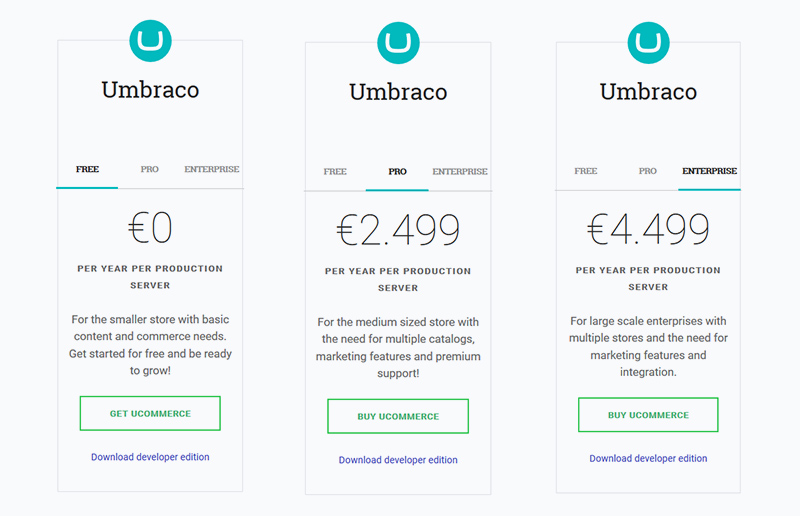
If you’re just starting out, you can get the free version of Ucommerce for Umbraco and upgrade to a paid version once your business scales.
There are two paid versions of Ucommerce for Umbraco that sport more advanced features - Umbraco Pro and Umbraco Enterprise. If you need more information you can check the official Ucommerce website.
Merchello for Umbraco
Being an open-source e-commerce engine, Merchello is free. However, if you want to contribute to the project and its development, you can purchase a Gratitude Licence for $100.
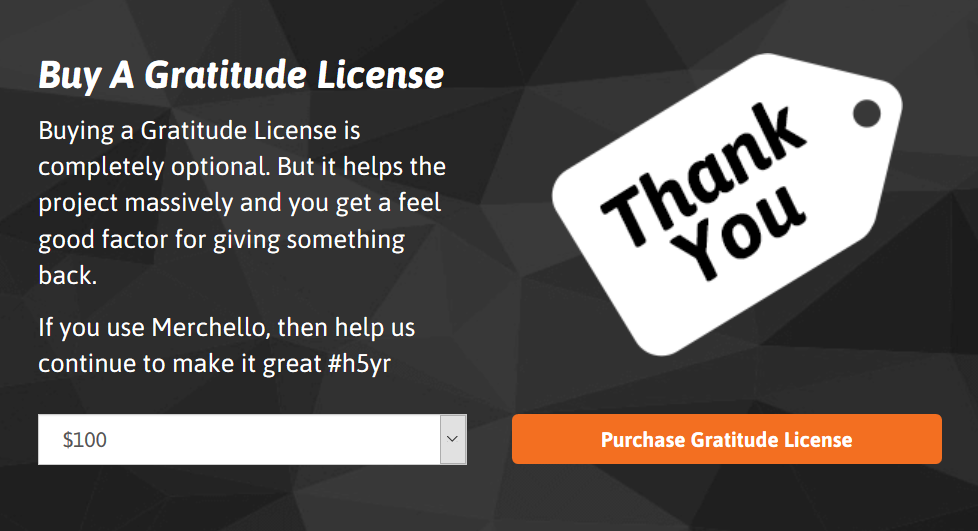
Wrap-up
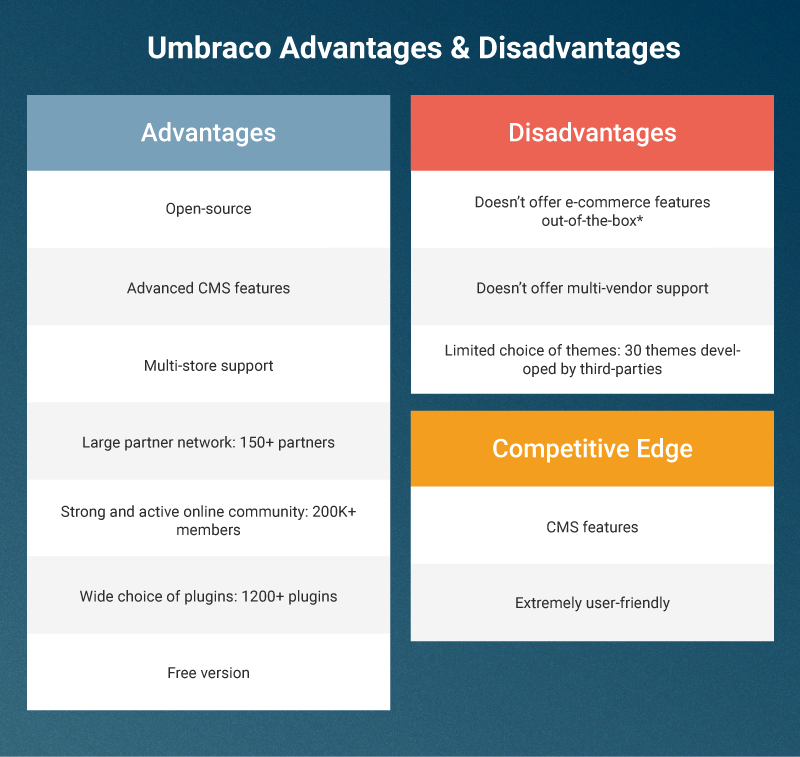
* If you want to add e-commerce features to your Umbraco website, you will need to integrate it with a third-party e-commerce solution. Ucommerce and Merchello, for example, are such solutions.
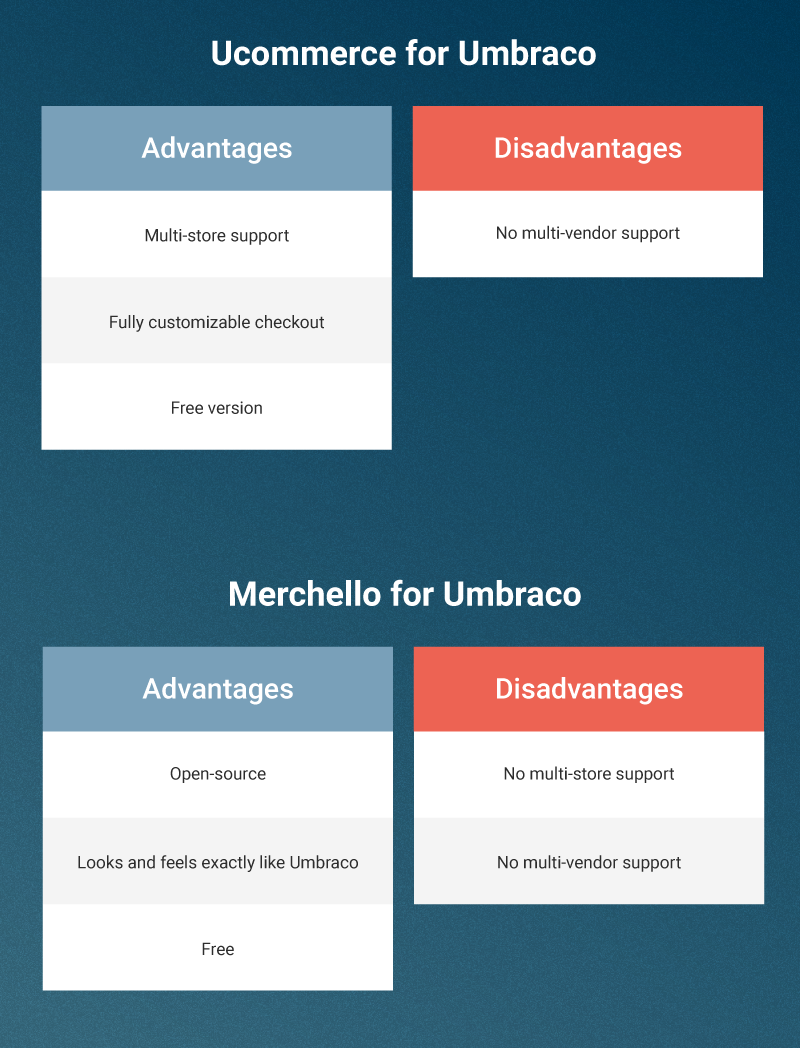
We hope this article gives you a better idea of what Umbraco can offer!
Stay tuned for our article on Kentico - the next blog post from the series dedicated to the best .NET e-commerce platforms!




